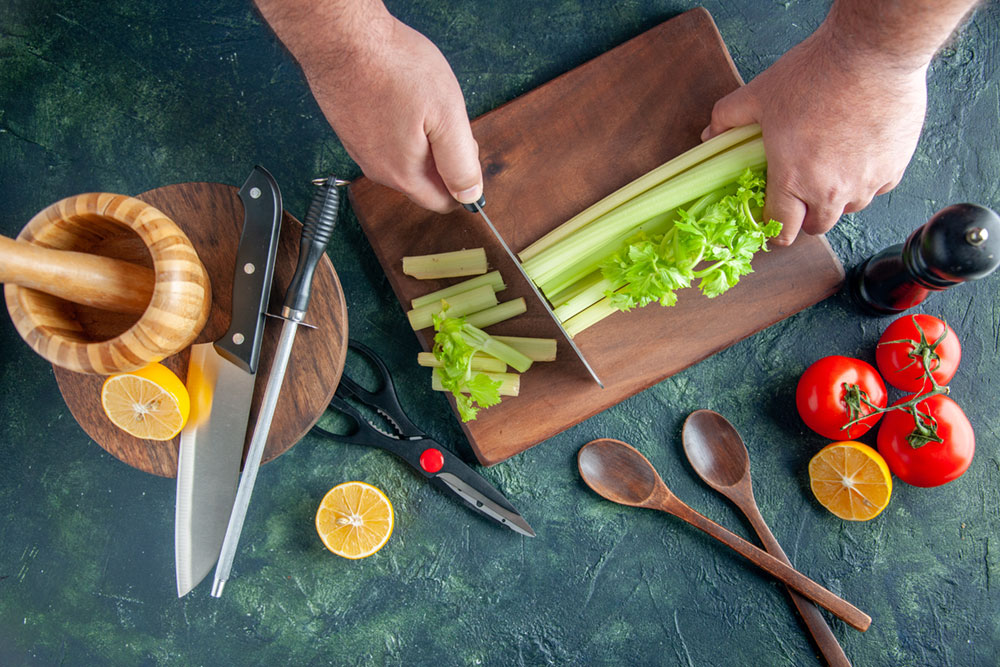Kitchen Knives and How to Use Them Safely – The Basics, Part 1

All articles on the subject of knives, especially kitchen ones, will tell you that a sharp knife is safer to use than one with a dull blade. While that is true for many reasons, it does not mean that you can ever let your guard down while using a knife. Understanding the basics of knife safety makes working in the kitchen much safer for everyone there.
Storage
Knife safety begins with storing them the right way. It's okay to store them in a drawer, as long as they are all properly sheathed. The sheath is to protect both the blade from damage in the drawer and your hand when you reach in to pick up a knife. A better option is to use a knife block. The block can be on the counter where you are working, making it quick and easy to access the knife you want. Whether you use a drawer or a block, it is vital to ensure that the knife is completely clean before returning it to the sheath or block. If not, dirt, oil and food particles remaining on the blade will collect in the sheath/block and this grime could transfer to the food when you next use the knife. Upset stomachs caused by residue on knife blades are more common than you may realize.
Another way is to use a magnetic knife strip. Being wall-mounted they do not take up counter space. Being in the open, there is no chance of dirt collecting in the storage cavity. Also, since you will be able to see all the knives on the strip, picking the one you want is easy.
The Cutting Surface
A strong, stable surface makes cutting both easier and safer. With a strong heavy wood or plastic cutting board, the risk of knife slippage and injury is minimized. The blades too are not going to be subjected to the kind of impact that occurs when the blade hits a hard surface. The harder the surface and impact force, the more wear and damage to the blade.
Never hold food in one hand and cut with the other. This is how most sliced fingers and palms occur.
Also Read: How Often Should You Sharpen Your Kitchen Knives?
Carrying a Knife
If you are carrying a knife to another part of the kitchen, you must always carry it with the tip of the blade pointing downwards and the sharp edge facing away from you. This reduces the risk of injury if you drop the knife or if you inadvertently move your arm with the knife in your hand.
The next part of this blog will contain more tips on knife safety in the kitchen.
A sharp knife can be the center of all the food prep done in the kitchen. Knowing how to use one makes cutting, peeling, dicing, and chopping safe. Knife safety protects both the user and the knife. But even with the best care, wear will, over time, gradually blunt the edge of even the best knives. If sharp knives are safer to use, then keeping them sharp is fundamental to kitchen safety. The best way to rejuvenate knives is to use a professional knife sharpening service that will return the blade to its original sharpness. A custom knife sharpening service will pick knives up, sharpen them expertly, and return them to you quickly, so you don’t have to waste time and energy traveling to the sharpening company. If you prefer easy mail-in knife sharpening solutions, that option is also available.
I ordered knife sharpening for my overused kitchen set, and the knives arrived to me in the perfect state. I especially appreciate company's communication with the customer. It is super easy to plan your day when you are waiting pick up and the delivery from Rejuvenated Knives, as the company has direct and easy-going communication with the customer, and provides you with the precise time frames so there is no need to sit at the home for the whole day. I will recommend this company to the neighbors and friends.
Happy Client
Elizaveta Mareeva
I ordered knife sharpening for my overused kitchen set, and the knives arrived to me in the perfect state. I especially appreciate company's communication with the customer. It is super easy to plan your day when you are waiting pick up and the delivery from Rejuvenated Knives, as the company has direct and easy-going communication with the customer, and provides you with the precise time frames so there is no need to sit at the home for the whole day. I will recommend this company to the neighbors and friends.
Frequently Asked Questions
How should I store kitchen knives safely?
Store knives in a knife block, on a magnetic strip, or in a drawer with blade guards to prevent accidents and damage.
What is the safest way to carry a kitchen knife?
Always carry a knife with the tip pointing down and the sharp edge facing away from your body.
What type of cutting board is best for knife safety?
Use a sturdy wooden or plastic cutting board to prevent slipping and minimize blade wear.
How often should I sharpen my kitchen knives?
Sharpen your knives every few months, depending on usage. A custom knife sharpening service ensures optimal sharpness.
Are mail-in knife sharpening solutions effective?
Yes, mail-in services provide professional sharpening with the convenience of doorstep pickup and return.
- Feb 20, 2025
